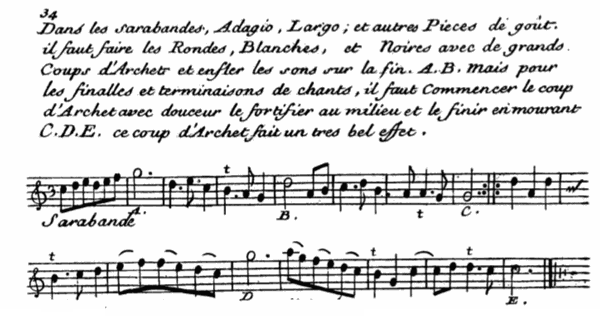A Timeline history of the Violin Bow - from c. 1600 - 1800
... the sources in detail ...
Michel Corrette (1707 - 1795)
L’école d’Orphée (Paris, 1738)
You can find an online version of the complete facsimile on imslp (click here).
Michel Corrette was a composer, teacher, organist and author of numerous methods on an astounding array of instruments - perhaps a bit like a French version of John Playford.
His L’école d’Orphée is particularly interesting, in that he explicitly details the difference between the Italian and French styles. Here is Chapter II complete:

"I show here the two different ways of holding the bow. The Italians hold it at three quarters by placing four fingers on the wood at A. and the thumb underneath at B. The French hold it next to the frog, by placing the first, second and third fingers on the wood at C.D.E. the thumb underneath the hair at F. and the little finger next to the wood at G. These two methods of holding the bow are equally good, it depends on the master who teaches you."
Here's a detail from Corrette's picture at the front of the treatise, showing the bow-hold.

What's curious here is that he seems to illustrate a mixture between the styles - the Italian position relatively high up the stick, but the (somewhat surprising) French position for the little finger, "next to the wood". You can't really see where the thumb is, but it's certainly not at Corrette's own position F - on the hair at the frog.
"It is necessary to play with the wood of the bow tilted a little towards the saddle, but not too much.
To draw the sound from the violin, you must bow up and down with large bow strokes, but graciously and nicely.
The 8ths and 16ths are played at the tip of the bow H.J. All the movements should come from the wrist, because those who always hold the arm rigid never play this instrument well. When one has two upbows in a row it is not necessary to retake the arm for the second bow-stroke. See page 34, where all the bow strokes are explained."
The following 3 chapters deal with the issues of stringing, tuning and trills (les Cadences). Following that, two sets of lessons, showing how to play respectively in the French style, and then the Italian. These are well worth studying in detail - the entire treatise is available to download on ismlp, here. To summarise briefly, the French style shows the kind of bowing we have come to expect - the typical adjustments to result in a down bow on the barline; for example (as ever, T = tirer = down bow, P = pousser = up bow):

But there are also surprising examples, where not only do we have an up bow on a bar-line, but on a longer note;



What we see is a clear relaxation of "Lully bowing" as presented by Muffat, but it is
definitely worth the trouble having a look for yourself! When we come to the Leçons du Violon pour apprendre a joüer dans le goût Italien, we have to swallow our disappointment! As soon as we see any music in triple time the bowing stops! Either it's all "as it comes" (why then does every note in duple time have a bowing), or Corrette is avoiding the issue.
After the Leçons, we come to the promised page 34. Actually, this is also a little disappointing - he talks essentially about slurring two, three or four notes. Of great interest however are his observations on the use of the messa di voce:


„In the Sarabandes, Adagio, Largo; and other pieces of taste, it is necessary to play the whole notes, half-notes and crotchets with long bow strokes and to swell the sound at the end. A.B. But for the final notes and the ends of pieces one should start the bow stroke sweetly, strengthen it in the middle, and finish it dying away C.D.E. this bow stroke makes a beautiful effect.“
At the very end of the treatise, he presents a short alphabetical list of the most commonly encountered Italian words - like allegro, fortissimo etc. Of interest here is his definition/translation of Staccato or Spiccato;
"... the bow strokes on violin, viola and cello should be played short, without dragging, and well detached. This one finds very often in the Largos and Adagios of concertos."
But notice that there is no comment about whether or not the bow should leave the string.